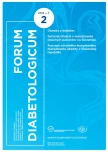Manažment obezitou indukovanej hypertenzie
Autoři:
Michał Holecki 1,2; Magdalena Zawadzka 2
Působiště autorů:
Department of Internal Medicine and Metabolic Diseases, School of Health Science, Medical University of Silesia, Katowice, Poland
1; Department of Internal Medicine, District Railway Hospital, Katowice, Poland
2
Vyšlo v časopise:
Forum Diab 2018; 7(2): 98-101
Kategorie:
Prehľadové práce
Souhrn
Obezita je epidémiou 21. storočia. V roku 2014 malo viac ako 1,9 miliardy dospelých nadváhu, z toho 600 miliónov osôb bolo obéznych. Obezitou trpí viac ako 42 miliónov detí vo veku nad 5 rokov. V roku 2015 pribudlo celosvetovo ďalších 100 miliónov obéznych dospelých osôb. Riziko rozvoja hypertenzie u obéznych dospelých je 2 - až 3-krát vyššie a u obéznych detí dokonca 7-krát vyššie, v porovnaní s jedincami s normálnou hmotnosťou. Obezita a hypertenzia sa súčasne vyskytuje u 78 % (65 %) hypertenzných mužov (žien). Vývoj hypertenzie je u obéznych pacientov spojený s mnohými centrálnymi a periférnymi abnormalitami, ako je aktivácia sympatického nervového systému a systému renín-angiotenzín-aldosterón; poškodenie funkcie endotelu; zvýšená retencia vody spôsobená nadmerným príjmom sodíka, zvýšená resorpcia sodíka v renálnych tubuloch a znížená hladina atriálneho natriuretického peptidu (ANP). Prehľadný článok sumarizuje vplyv obezity na kardiovaskulárny systém, niektoré charakteristické znaky hypertenzie vyvolanej obezitou, najvhodnejšiu liečbu a taktiež najčastejšie chyby v terapii.
Kľúčové slová:
ABPM antihypertenzíva hemodynamika hypertenzia hypertenzia asociovaná s obezitou kardiovaskulárny systém krvný tlak obezita sympatický nervový systém systém renín-angiotenzín-aldosterón
Zdroje
- Pêgo-Fernandes PM, Bibas BJ, Deboni M. Obesity: the greatest epidemic of the 21st century? Sao Paulo Med J 2011; 129(5): 283–284.
- Finkelstein EA, Khavjou OA, Thompson H et al. Obesity and se - vere obesity forecasts through 2030. Am J Prev Med 2012; 42(6): 563–570. Available on DOI: <http://dx.doi.org/10.1016/j.amepre.2011.10.026>.
- Jiang S-Z, Lu W, Zong X-F, Ruan H-Y et al. Obesity and hypertension. Exp Ther Med 2016; 12(4): 2395–2399. Available on DOI: <http://dx.doi.org/10.3892/etm.2016.3667>.
- Baptista V, Wassef W. Bariatric procedures: an update on tech - niques, outcomes and complications. Curr Opin Gastroenterol 2013; 29(6): 684–693. Available on DOI: <http://dx.doi.org/10.1097/MOG.0b013e3283651af2>.
- Obesity: preventing and managing the global epidemic. Report of a WHO consultation. World Health Organ Tech Rep Ser 2000; 894:i-xii, 1–253. Available on WWW: <http://http://apps.who.int/iris/handle/10665/63854>.
- Garrison R, Kannel W, Stokes J et al. Incidence and precursors of hyperten - sion in young adults. The Framingham Offspring Study. Prev Med 1987;16(2): 235–251.
- Wofford M, Hall J. Pathophysiology and treatment of obesity hypertension. Curr Pharm Des 2004; 10(29): 3621–37.
- Montani JP, Antic V, Yang Z et al. Pathways from obesity to hypertension: from the perspective of a viscious triangle. Int J Obes Relat Metab Disord 2002; 26(Suppl 2): S28–S38. Available on DOI: <http://dx.doi.org/10.1038/sj.ijo.0802125>.
- Aneja A, El-Atat F, McFarlane S et al. Hypertension and obesity. Recent Prog Horm Res 2004; 59 : 169–205.
- Nishizaka MK, Pratt-Ubunama M, Zaman MA et al. Validity of plasma aldosterone-to-renin activity ratio in African American and white subjects with resistant hypertension. Am J Hypertens 2005; 18(6): 805–812. Available on DOI: <http://dx.doi.org/10.1016/j.amjhyper.2005.01.002>.
- Alpert MA, Omran J, Bostick BP. Effects of Obesity on Cardiovascular Hemodynamics, Cardiac Morphology, and Ventricular Function. Curr Obes Rep 2016; 5(4): 424–434. Available on DOI: <http://dx.doi.org/10.1007/s13679–016–0235–6>.
- Brown MA, Buddle ML, Martin A. Is resistant hypertension really resistant? Am J Hypertens 2001; 14(12): 1263–1269.
- Zasady postępowania w nadciśnieniu tętniczym — 2015 rok Wytyczne Polskiego Towarzystwa Nadciśnienia Tętniczego. Available on WWW: Available on DOI: <https://nadcisnienietetnicze.pl/ptnt/wytyczne_ptnt>.
- [European Society of Hypertension‐European Society of Cardiology Guidelines Committee]. 2003 European Society of Hypertension‐European Society of Cardiology Guidelines for the management of arterial hypertension. J Hypertens 2003; 21(6): 1011–1053. Available on DOI: <http://dx.doi.org/10.1097/01.hjh.0000059051.65882.32>. Erratum in J Hypertens. 2003; 21(11): 2203–2204. J Hypertens 2004; 22(2): 435.
- Mancia G, De Backer G, Dominiczak A et al. 2007 Guidelines for the management of arterial hypertension: The Task Force for the Management of Arterial Hypertension of the European Society of Hypertension (ESH) and of the European Society of Cardiology (ESC). Eur Heart J 2007; 28(12): 1462‐1536. Available on DOI: <http://dx.doi.org/10.1093/eurheartj/ehm236>.
- Grzybowski A, Bellwon J, Gruchała M et al. Effectiveness of hypertension treatment assessed by blood pressure level achieved in primary care in Poland. Blood Press 2003; 12(4): 232‐238.
- Fang J, Alderman M, Keenan N et al. Hypertension control at phy ‐ sicians’ offices in the United States. Am J Hypertens 2008; 21(2): 136–142. Available on DOI: <http://dx.doi.org/10.1038/ajh.2007.35>.
- Zygmuntowicz M, Owczarek A, Elibol A et. al. Comorbidities and the quality of life in hypertensive patients. Pol Arch Med Wewn 2012; 122(7): 333‐340.
- Sharma A, Wittchen HU, Kirch W et al. [HYDRA Study Group]. High prevalence and poor control of hypertension in primary care: cross‐section ‐ al study. J Hypertens 2004; 22(3): 479–486.
- Rose A, Berlowitz D, Orner M et al. Understanding uncontrolled hypertension: is it the patient or the provider? J Clin Hypertens (Greenwhich) 2007; 9(12): 937‐943.
- Sever PS. The heterogenity of hypertension. Eur Heart J 1999; 1(Suppl 1): L10-L13.
- Kolasińska-Malkowska K, Tykarski A. Terapia pierwszego rzutu w nadciśnieniu tętniczym — rola preparatów złożonych. Nadciśnienie tętnicze 2007; Suppl B: B1-B8. Available on WWW: <https://journals.viamedica.pl/arterial_hypertension/article/viewFile/12449/10286>.
- Żak-Gołąb A, Holecki M, Smertka M et al. Do primary care physicians follow the current recommendations for hypertensive pharmacotherapy? Pol Arch Med Wewn 2013; 123(5): 206–214.
- Gatley MS. To be taken as directed. Coll Gen Pract 1968; 16(1): 39–44.
- Dahlöf B, Sever PS, Poulter NR et al. [ASCOT Investigators]. Prevention of cardiovascular events with an antihypertensive regimen of amlodipine adding perindopril as required versus atenolol adding bendroflumethiazide as required, in the Anglo-Scandinavian Cardiac Outcomes Trial-Blood Pressure Lowering Arm (ASCOT-BPLA): a multicentre randomized controlled trial. Lancet 2005; 366(9489): 895‐906. Available on DOI: <http://dx.doi.org/10.1016/S0140–6736(05)67185–1>.
Štítky
Diabetologie Endokrinologie Interní lékařstvíČlánek vyšel v časopise
Forum Diabetologicum

2018 Číslo 2
Nejčtenější v tomto čísle
- Nealkoholová tuková choroba pečene a metabolický syndróm
- Súčasná situácia v manažmente obéznych pacientov na Slovensku: koncept národného komplexného manažmentu obezity v Slovenskej republike
- Dokáže bariatrická chirurgia pomôcť v liečbe obéznych diabetikov 2. typu?
- Paradox obezity u srdcového zlyhávania
